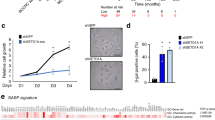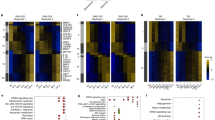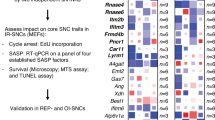Abstract
Cellular senescence is an antiproliferative response with essential functions in tumor suppression and tissue homeostasis. Here we show that SIX1, a member of the SIX family of homeobox transcriptional factors, is a novel repressor of senescence. Our data show that SIX1 is specifically downregulated in fibroblasts upon oncogenic stress and other pro-senescence stimuli, as well as in senescent skin premalignant lesions. Silencing of SIX1 in human fibroblasts suffices to trigger senescence, which is mediated by p16INK4A and lacks a canonical senescence-associated secretory phenotype. Interestingly, SIX1-associated senescence is further characterized by the expression of a set of development and differentiation-related genes that significantly overlap with genes associated with SIX1 in organogenesis or human tumors, and show coincident regulation in oncogene-induced senescence. Mechanistically, we show that gene regulation by SIX1 during senescence is mediated, at least in part, by cooperation with Polycomb repressive complexes. In summary, our results identify SIX1, a key development regulator altered in human tumors, as a critical repressor of cellular senescence, providing a novel connection between senescence, differentiation and tumorigenesis.
This is a preview of subscription content, access via your institution
Access options
Subscribe to this journal
Receive 50 print issues and online access
$259.00 per year
only $5.18 per issue
Buy this article
- Purchase on Springer Link
- Instant access to full article PDF
Prices may be subject to local taxes which are calculated during checkout






Similar content being viewed by others
References
Kuilman T, Michaloglou C, Mooi WJ, Peeper DS . The essence of senescence. Genes Dev 2010; 24: 2463–2479.
Munoz-Espin D, Serrano M . Cellular senescence: from physiology to pathology. Nat Rev Mol Cell Biol 2014; 15: 482–496.
Salama R, Sadaie M, Hoare M, Narita M . Cellular senescence and its effector programs. Genes Dev 2014; 28: 99–114.
Perez-Mancera PA, Young AR, Narita M . Inside and out: the activities of senescence in cancer. Nat Rev Cancer 2014; 14: 547–558.
Lanigan F, Geraghty JG, Bracken AP . Transcriptional regulation of cellular senescence. Oncogene 2011; 30: 2901–2911.
Chandra T, Kirschner K, Thuret JY, Pope BD, Ryba T, Newman S et al. Independence of repressive histone marks and chromatin compaction during senescent heterochromatic layer formation. Mol Cell 2012; 47: 203–214.
Christensen KL, Patrick AN, McCoy EL, Ford HL . The six family of homeobox genes in development and cancer. Adv Cancer Res 2008; 101: 93–126.
Patrick AN, Cabrera JH, Smith AL, Chen XS, Ford HL, Zhao R . Structure-function analyses of the human SIX1-EYA2 complex reveal insights into metastasis and BOR syndrome. Nat Struct Mol Biol 2013; 20: 447–453.
Tadjuidje E, Hegde RS . The Eyes Absent proteins in development and disease. Cell Mol Life Sci 2013; 70: 1897–1913.
Le Grand F, Grifone R, Mourikis P, Houbron C, Gigaud C, Pujol J et al. Six1 regulates stem cell repair potential and self-renewal during skeletal muscle regeneration. J Cell Biol 2012; 198: 815–832.
Xia Y, Nivet E, Sancho-Martinez I, Gallegos T, Suzuki K, Okamura D et al. Directed differentiation of human pluripotent cells to ureteric bud kidney progenitor-like cells. Nat Cell Biol 2013; 15: 1507–1515.
Xu PX . The EYA-SO/SIX complex in development and disease. Pediatr Nephrol 2013; 28: 843–854.
Orten DJ, Fischer SM, Sorensen JL, Radhakrishna U, Cremers CW, Marres HA et al. Branchio-oto-renal syndrome (BOR): novel mutations in the EYA1 gene, and a review of the mutational genetics of BOR. Hum Mutat 2008; 29: 537–544.
Farabaugh SM, Micalizzi DS, Jedlicka P, Zhao R, Ford HL . Eya2 is required to mediate the pro-metastatic functions of Six1 via the induction of TGF-beta signaling, epithelial-mesenchymal transition, and cancer stem cell properties. Oncogene 2012; 31: 552–562.
Auvergne RM, Sim FJ, Wang S, Chandler-Militello D, Burch J, Al Fanek Y et al. Transcriptional differences between normal and glioma-derived glial progenitor cells identify a core set of dysregulated genes. Cell Rep 2013; 3: 2127–2141.
Abad M, Moreno A, Palacios A, Narita M, Blanco F, Moreno-Bueno G et al. The tumor suppressor ING1 contributes to epigenetic control of cellular senescence. Aging Cell 2011; 10: 158–171.
Serrano M, Lin AW, McCurrach ME, Beach D, Lowe SW . Oncogenic ras provokes premature cell senescence associated with accumulation of p53 and p16INK4a. Cell 1997; 88: 593–602.
Palmero I, Pantoja C, Serrano M . p19ARF links the tumour suppressor p53 to Ras [letter]. Nature 1998; 395: 125–126.
Young AR, Narita M, Ferreira M, Kirschner K, Sadaie M, Darot JF et al. Autophagy mediates the mitotic senescence transition. Genes Dev 2009; 23: 798–803.
Acosta JC, O'Loghlen A, Banito A, Guijarro MV, Augert A, Raguz S et al. Chemokine signaling via the CXCR2 receptor reinforces senescence. Cell 2008; 133: 1006–1018.
Lin AW, Barradas M, Stone JC, van Aelst L, Serrano M, Lowe SW . Premature senescence involving p53 and p16 is activated in response to constitutive MEK/MAPK mitogenic signaling. Genes Dev 1998; 12: 3008–3019.
Collado M, Blasco MA, Serrano M . Cellular senescence in cancer and aging. Cell 2007; 130: 223–233.
Coppe JP, Patil CK, Rodier F, Sun Y, Munoz DP, Goldstein J et al. Senescence-associated secretory phenotypes reveal cell-nonautonomous functions of oncogenic RAS and the p53 tumor suppressor. PLoS Biol 2008; 6: 2853–2868.
Collado M, Gil J, Efeyan A, Guerra C, Schuhmacher AJ, Barradas M et al. Tumour biology: senescence in premalignant tumours. Nature 2005; 436: 642.
Narita M, Nunez S, Heard E, Narita M, Lin AW, Hearn SA et al. Rb-mediated heterochromatin formation and silencing of E2F target genes during cellular senescence. Cell 2003; 113: 703–716.
Di Micco R, Fumagalli M, Cicalese A, Piccinin S, Gasparini P, Luise C et al. Oncogene-induced senescence is a DNA damage response triggered by DNA hyper-replication. Nature 2006; 444: 638–642.
Acosta JC, Banito A, Wuestefeld T, Georgilis A, Janich P, Morton JP et al. A complex secretory program orchestrated by the inflammasome controls paracrine senescence. Nat Cell Biol 2013; 15: 978–990.
Gil J, Peters G . Regulation of the INK4b-ARF-INK4a tumour suppressor locus: all for one or one for all. Nat Rev Mol Cell Biol 2006; 7: 667–677.
Kumar JP . The sine oculis homeobox (SIX) family of transcription factors as regulators of development and disease. Cell Mol Life Sci 2009; 66: 565–583.
Yu Y, Davicioni E, Triche TJ, Merlino G . The homeoprotein six1 transcriptionally activates multiple protumorigenic genes but requires ezrin to promote metastasis. Cancer Res 2006; 66: 1982–1989.
Laugesen A, Helin K . Chromatin repressive complexes in stem cells, development, and cancer. Cell Stem Cell 2014; 14: 735–751.
Barradas M, Anderton E, Acosta JC, Li S, Banito A, Rodriguez-Niedenfuhr M et al. Histone demethylase JMJD3 contributes to epigenetic control of INK4a/ARF by oncogenic RAS. Genes Dev 2009; 23: 1177–1182.
Pemberton H, Anderton E, Patel H, Brookes S, Chandler H, Palermo R et al. Genome-wide co-localization of Polycomb orthologs and their effects on gene expression in human fibroblasts. Genome Biol 2014; 15: R23.
Eid JE, Garcia CB . Reprogramming of mesenchymal stem cells by oncogenes. Semin Cancer Biol 2014; 32: 18–31.
Buckingham M, Rigby PW . Gene regulatory networks and transcriptional mechanisms that control myogenesis. Dev Cell 2014; 28: 225–238.
Li X, Oghi KA, Zhang J, Krones A, Bush KT, Glass CK et al. Eya protein phosphatase activity regulates Six1-Dach-Eya transcriptional effects in mammalian organogenesis. Nature 2003; 426: 247–254.
Laclef C, Souil E, Demignon J, Maire P . Thymus, kidney and craniofacial abnormalities in Six 1 deficient mice. Mech Dev 2003; 120: 669–679.
Di Croce L, Helin K . Transcriptional regulation by Polycomb group proteins. Nat Struct Mol Biol 2013; 20: 1147–1155.
Liu Y, Chakroun I, Yang D, Horner E, Liang J, Aziz A et al. Six1 regulates MyoD expression in adult muscle progenitor cells. PLoS One 2013; 8: e67762.
Irelan JT, Gutierrez Del Arroyo A, Gutierrez A, Peters G, Quon KC, Miraglia L et al. A functional screen for regulators of CKDN2A reveals MEOX2 as a transcriptional activator of INK4a. PLoS One 2009; 4: e5067.
Martin N, Popov N, Aguilo F, O'Loghlen A, Raguz S, Snijders AP et al. Interplay between Homeobox proteins and Polycomb repressive complexes in p16INK(4)a regulation. EMBO J 2013; 32: 982–995.
Delgado-Olguin P, Huang Y, Li X, Christodoulou D, Seidman CE, Seidman JG et al. Epigenetic repression of cardiac progenitor gene expression by Ezh2 is required for postnatal cardiac homeostasis. Nat Genet 2012; 44: 343–347.
Mikkelsen TS, Ku M, Jaffe DB, Issac B, Lieberman E, Giannoukos G et al. Genome-wide maps of chromatin state in pluripotent and lineage-committed cells. Nature 2007; 448: 553–560.
Kirschner K, Samarajiwa SA, Cairns JM, Menon S, Perez-Mancera PA, Tomimatsu K et al. Phenotype specific analyses reveal distinct regulatory mechanism for chronically activated p53. PLoS Genet 2015; 11: e1005053.
Coppe JP, Rodier F, Patil CK, Freund A, Desprez PY, Campisi J . Tumor suppressor and aging biomarker p16(INK4a) induces cellular senescence without the associated inflammatory secretory phenotype. J Biol Chem 2011; 286: 36396–36403.
Imai Y, Takahashi A, Hanyu A, Hori S, Sato S, Naka K et al. Crosstalk between the Rb pathway and AKT signaling forms a quiescence-senescence switch. Cell Rep 2014; 7: 194–207.
Rodier F, Coppe JP, Patil CK, Hoeijmakers WA, Munoz DP, Raza SR et al. Persistent DNA damage signalling triggers senescence-associated inflammatory cytokine secretion. Nat Cell Biol 2009; 11: 973–979.
Kuilman T, Michaloglou C, Vredeveld LC, Douma S, van Doorn R, Desmet CJ et al. Oncogene-induced senescence relayed by an interleukin-dependent inflammatory network. Cell 2008; 133: 1019–1031.
Chien Y, Scuoppo C, Wang X, Fang X, Balgley B, Bolden JE et al. Control of the senescence-associated secretory phenotype by NF-kappaB promotes senescence and enhances chemosensitivity. Genes Dev 2011; 25: 2125–2136.
Xu PX, Zheng W, Huang L, Maire P, Laclef C, Silvius D . Six1 is required for the early organogenesis of mammalian kidney. Development 2003; 130: 3085–3094.
Wong EY, Ahmed M, Xu PX . EYA1-SIX1 complex in neurosensory cell fate induction in the mammalian inner ear. Hear Res 2013; 297: 13–19.
Coletta RD, McCoy EL, Burns V, Kawakami K, McManaman JL, Wysolmerski JJ et al. Characterization of the Six1 homeobox gene in normal mammary gland morphogenesis. BMC Dev Biol 2010; 10: 4.
McCoy EL, Iwanaga R, Jedlicka P, Abbey NS, Chodosh LA, Heichman KA et al. Six1 expands the mouse mammary epithelial stem/progenitor cell pool and induces mammary tumors that undergo epithelial-mesenchymal transition. J Clin Invest 2009; 119: 2663–2677.
Sehic D, Karlsson J, Sandstedt B, Gisselsson D . SIX1 protein expression selectively identifies blastemal elements in Wilms tumor. Pediatr Blood Cancer 2012; 59: 62–68.
Iwanaga R, Wang CA, Micalizzi DS, Harrell JC, Jedlicka P, Sartorius CA et al. Expression of Six1 in luminal breast cancers predicts poor prognosis and promotes increases in tumor initiating cells by activation of extracellular signal-regulated kinase and transforming growth factor-beta signaling pathways. Breast Cancer Res 2012; 14: R100.
Banito A, Rashid ST, Acosta JC, Li S, Pereira CF, Geti I et al. Senescence impairs successful reprogramming to pluripotent stem cells. Genes Dev 2009; 23: 2134–2139.
Li H, Collado M, Villasante A, Strati K, Ortega S, Canamero M et al. The Ink4/Arf locus is a barrier for iPS cell reprogramming. Nature 2009; 460: 1136–1139.
Utikal J, Polo JM, Stadtfeld M, Maherali N, Kulalert W, Walsh RM et al. Immortalization eliminates a roadblock during cellular reprogramming into iPS cells. Nature 2009; 460: 1145–1148.
Storer M, Mas A, Robert-Moreno A, Pecoraro M, Ortells MC, Di Giacomo V et al. Senescence is a developmental mechanism that contributes to embryonic growth and patterning. Cell 2013; 155: 1119–1130.
Munoz-Espin D, Canamero M, Maraver A, Gomez-Lopez G, Contreras J, Murillo-Cuesta S et al. Programmed cell senescence during mammalian embryonic development. Cell 2013; 155: 1104–1118.
Sousa-Victor P, Gutarra S, Garcia-Prat L, Rodriguez-Ubreva J, Ortet L, Ruiz-Bonilla V et al. Geriatric muscle stem cells switch reversible quiescence into senescence. Nature 2014; 506: 316–321.
Gomez-Cabello D, Adrados I, Gamarra D, Kobayashi H, Takatsu Y, Takatsu K et al. DGCR8-mediated disruption of miRNA biogenesis induces cellular senescence in primary fibroblasts. Aging Cell 2013; 12: 923–931.
Palmero I, Murga M, Zubiaga A, Serrano M . Activation of ARF by oncogenic stress in mouse fibroblasts is independent of E2F1 and E2F2. Oncogene 2002; 21: 2939–2947.
Menendez C, Adrados I, Fernandez-Barral A, Jimenez B, Flores JM, Canamero M et al. Increased melanoma formation and dissemination in TyrNRas mice deficient in the tumor suppressor Ing1. Pigment Cell Melanoma Res 2014; 27: 674–677.
Gomez-Cabello D, Callejas S, Benguria A, Moreno A, Alonso J, Palmero I . Regulation of the microRNA processor DGCR8 by the tumor suppressor ING1. Cancer Res 2010; 70: 1866–1874.
Acknowledgements
We thank Manuel Serrano, Daniel Peeper and René Bernards for cells and reagents, and Masashi Narita for reagents and sharing unpublished data. This work was supported by grants from the Spanish Government (SAF2012-32117) to IP, Instituto de Salud Carlos III (PI13/00132 and RETIC-RD12/0036/0007) and Regional Government of Madrid (S2010/BMD-2303) to GM-B. IA is the recipient of a fellowship from the Spanish Government FPI program.
Author information
Authors and Affiliations
Corresponding author
Ethics declarations
Competing interests
The authors declare no conflict of interest.
Additional information
Supplementary Information accompanies this paper on the Oncogene website
Rights and permissions
About this article
Cite this article
Adrados, I., Larrasa-Alonso, J., Galarreta, A. et al. The homeoprotein SIX1 controls cellular senescence through the regulation of p16INK4A and differentiation-related genes. Oncogene 35, 3485–3494 (2016). https://doi.org/10.1038/onc.2015.408
Received:
Revised:
Accepted:
Published:
Issue Date:
DOI: https://doi.org/10.1038/onc.2015.408
This article is cited by
-
Circular RNA circNHSL1 promotes gastric cancer progression through the miR-1306-3p/SIX1/vimentin axis
Molecular Cancer (2019)
-
SIX1 represses senescence and promotes SOX2-mediated cellular plasticity during tumorigenesis
Scientific Reports (2019)
-
Novel insights into a reputably irreversible process: combined mRNA and miRNA profiling of tissue from vesicourethral anastomotic stenosis after radical prostatectomy
World Journal of Urology (2017)



